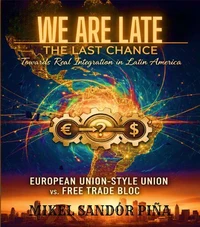SYNOPSIS What is best for Latin America: a European Union-style Latin American union or a free trade agreement that creates a solid economic bloc?"The Last Chance: Towards Real Integration in Latin America"What if Latin America could cease to be a patchwork of frustrations and become a global power? What if the dream of regional integration weren't a utopia, but a pending roadmap?This book is not an ideological pamphlet or a compendium of good wishes.
It is a technical, political, and strategic project to transform the destiny of a region that, for centuries, has had everything it needed to take off... except a shared vision. Through hard data, simulations, successful experiences, and historical warnings, "The Last Chance" dissects the errors that have doomed Latin American integration to failure: symbolic blocs, toothless treaties, short-term leadership, and alliances that have included authoritarian regimes that sabotage from within.
But it also offers a viable path forward: a model of progressive integration that starts with the possible-such as a robust free trade zone between trusted countries-and moves toward the ambitious: dignified regional mobility, a common digital currency, supranational governance, and a unified voice in global forums. Possible scenarios if the proposed model is applied: Positive scenario (2045): Latin America operates with a logistics network connected by efficient trains and ports, a regional work visa allows for controlled movement of talent, and SMEs export with common rules and fair financing.
The bloc negotiates with China, the US, and the EU as a single player, while citizens enjoy borderless access to healthcare and education. Intermediate risk scenario (2035): Integration advances only among democratic and trustworthy countries, while isolated dictatorships face sanctions and blockades. The benefits are concentrated in the "trustworthy perimeter, " and social pressure forces institutional changes on those lagging behind.
Failure scenario (2029) A hasty attempt to integrate authoritarian regimes without filters collapses the bloc: courts become paralyzed, trade disputes arise without resolution, disorderly migration increases, and investor confidence fades. A new cycle of regional disillusionment sets in for decades.
SYNOPSIS What is best for Latin America: a European Union-style Latin American union or a free trade agreement that creates a solid economic bloc?"The Last Chance: Towards Real Integration in Latin America"What if Latin America could cease to be a patchwork of frustrations and become a global power? What if the dream of regional integration weren't a utopia, but a pending roadmap?This book is not an ideological pamphlet or a compendium of good wishes.
It is a technical, political, and strategic project to transform the destiny of a region that, for centuries, has had everything it needed to take off... except a shared vision. Through hard data, simulations, successful experiences, and historical warnings, "The Last Chance" dissects the errors that have doomed Latin American integration to failure: symbolic blocs, toothless treaties, short-term leadership, and alliances that have included authoritarian regimes that sabotage from within.
But it also offers a viable path forward: a model of progressive integration that starts with the possible-such as a robust free trade zone between trusted countries-and moves toward the ambitious: dignified regional mobility, a common digital currency, supranational governance, and a unified voice in global forums. Possible scenarios if the proposed model is applied: Positive scenario (2045): Latin America operates with a logistics network connected by efficient trains and ports, a regional work visa allows for controlled movement of talent, and SMEs export with common rules and fair financing.
The bloc negotiates with China, the US, and the EU as a single player, while citizens enjoy borderless access to healthcare and education. Intermediate risk scenario (2035): Integration advances only among democratic and trustworthy countries, while isolated dictatorships face sanctions and blockades. The benefits are concentrated in the "trustworthy perimeter, " and social pressure forces institutional changes on those lagging behind.
Failure scenario (2029) A hasty attempt to integrate authoritarian regimes without filters collapses the bloc: courts become paralyzed, trade disputes arise without resolution, disorderly migration increases, and investor confidence fades. A new cycle of regional disillusionment sets in for decades.

 , qui est-ce ?
, qui est-ce ?